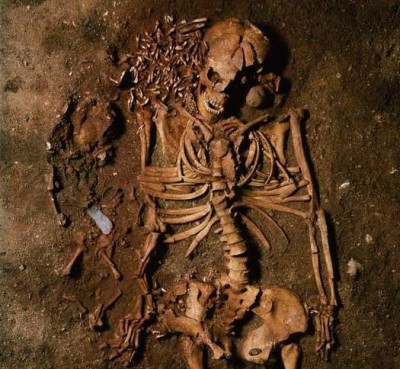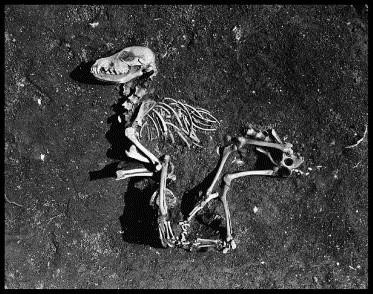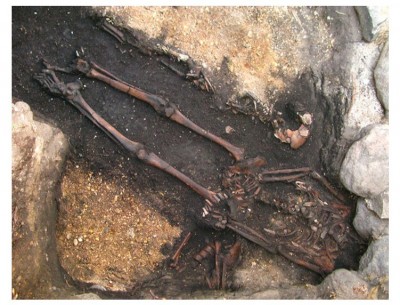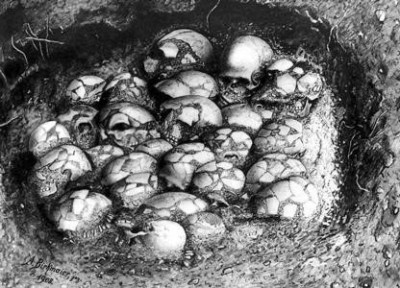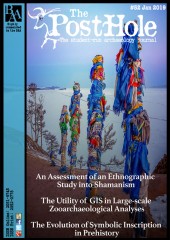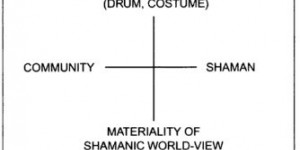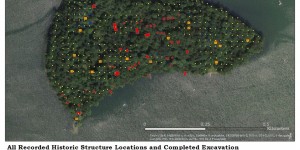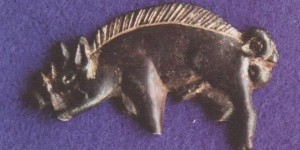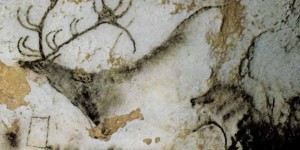Introduction
Mortuary rites are one of the quintessential sources of evidence in the archaeological record for understanding human behaviour and ideologies of the time, particularly in the case of prehistory where there are no written records and often very limited evidence in comparison to historical periods. Nilsson Stutz (2003, 81) states that “the ways that the living handle the cadaver relates to attitudes toward the body, the self and other, the dead and the living, culture and nature, order and disorder, and the present, the future and the past.” This highlights that mortuary practices are a key place for archaeologists to start in terms of making inferences about social organisation, relationships, political structures, ideologies, religious beliefs, economy and technology. Jacobi (2003, 810) emphasizes that in prehistory it is the location of the bodies, the skeletal remains and perhaps the grave goods within the burials that remain once a culture and society has gone. Archaeologists are unable to authenticate what words were said, what actions were performed, and who had surrounded the bodies and witnessed the mortuary practices.
However, the varying different ways of treating the body after death in prehistory can tell us a great deal about customs, ideologies and beliefs at the time, through interpretation and often comparisons with ethnography.
Mesolithic Burials
As with any period, there is huge variability with the treatment of the body after death, depending on a number of factors such as location and group identity. It is critical to remember when analysing the evidence that this likely represents only a small percentage of a larger population, and one form of mortuary practice was perhaps not a single practice expressive of common behaviour for that society, rather one choice out of many – just like today. This essay will examine what inhumation and disarticulation can tell us about mortuary customs, ideologies and beliefs within the Mesolithic, a period that has arguably been neglected within prehistory (Blinkhorn & Milner 2014).
Inhumation, sometimes referred to as formal burial, can be defined as “the creation of an artificial place for the purposes of containing a corpse” (Pettitt 2011, 9). It consists of a three-stage process which can be summarised as: the excavation of an artificial pit to serve as a grave, internment of the body and finally the covering of the body with the extracted sediment (Pettitt 2011, 9). The Mesolithic period saw a significant rise in the use of cemeteries, defined as “places given over in the main or entirely to the dead, with little or no evidence of settlement” (Pettitt 2011, 10). These are often associated with the beginnings of human complexity (Conneller 2013), though Nilsson Stutz (2003) encourages us to remember that a complex society does not always perform complex mortuary practices and vice versa.
Burial Variations
Vedbaek-Bogebakken, dated to 5900BP, and Skateholm I and II, dated to 6290 – 5930BP and 6910-6000BP respectively, are amongst the largest and best-known burial ensembles from this period in Northern Europe, along with sites such as Oleni’Ostrov (O’Shea & Zvelebil 1984; Jacobs 1995) and Zvejnieki (Zagorska 2016). These two extremely rich Scandinavian sites tell archaeologists huge amounts about Mesolithic ideas, beliefs and customs due to their excellent preservation and wide varieties of evidence. For example, it is interesting to note that within the burial numbers at Vedbaek there is a noticeable absence of children and adolescents, with only adults and infants being represented (as in Figure 1).
Strassburg (2000) proposes various interpretations for this relationship between presence and absence seen at Vedbaek, suggesting that children were more likely to be disarticulated and deposited in the lake-edge contexts. He then suggests that this indicates older children and adolescents had achieved separation from their parents prior to their death but had not quite developed the full social persona necessary for burial at the cemetery. Infants, however, were still seen as part of their parents and were not yet individual persons, hence their burial alongside adults, presumably their parents. The use of space can also express a distinction between ‘normal’ and ‘deviant’ burials, with Cole suggesting that the general age and sex profile of the burials are not representative of an ordinary population; instead there is a large population consisting of those in mid-life and perhaps those who died in childbirth, as well as again the lack of children and mature adults (Parker Pearson 2003; Strassburg 2000).
Dogs and Domestication in Burial Contexts
The domestication of dogs within prehistory is extremely interesting, and burials containing dogs give great insight many aspects of prehistoric life including social relationships and ideologies. Variability in the treatment of dogs, particularly at Skateholm, is in many ways equivalent to the treatment of humans. Much like humans, not all dogs were buried, and were therefore specifically selected for burial and only represent a small percentage of a larger population (Conneller 2013). Similarly to infant burials, dog burials are often carefully arranged and prepared (see Fig. 2), and could be buried either flexed or extended, whole or part. Often, they are buried close to a human who may appear to be their owner perhaps symbolising how important dogs were to people and daily life in these societies (Morey 2006).
These burials have been explained, like some cases of human burials, as a way of disposing of the remains in a hygienic manner, away from the general living space. However, when considering the degree of care and preparation that has been put into some of these burials, as well as the overall number found, it appears to become much more symbolic and meaningful for these communities. When compared with the other burials at Vedbaek and Skateholm, particularly those with infants, these burials raise interesting questions regarding whether some dogs were considered more powerful or socially complete than other members of society; for example children, which are completely absent in these Scandinavian cemeteries. Another idea is that, in some instances, dogs were buried in place of their owner to ‘fill in’ for the fact that a body could not be transported to the burial site. Furthermore, this high level of care towards dogs demonstrates that inter-species relations were arguably important to Mesolithic people and sometimes equal to inter-personal relationships.
Post-Mortem Transformations
Nilsson Stutz (2003) argues that the transformation of people after death is performed through the following methods in order to maintain personhood and identity in death:
- A concern with the maintenance of an intact body through burial
- An attempt to arrange the cadaver in the position of the living (e.g. sitting/lying)
- Concern shown in wrapping/lifting the body from the grave structure
- An attempt to hide the messy, dangerous and disturbing process of decay from the living
The Latvian site of Zvejnieki, dating to 9000-3500BP, holds 330 burials (Zargoska 2016) and is a perfect example of how burial traditions express the economic, social and cultural characteristics of the society. The large number of burials and individuals allows potential patterns and links to be observed. For example, there is significant evidence from the site indicative of some bodies being wrapped pre-internment, particularly burial 93 (Zargoska 2016). This adult male is buried in a light grey grave with small stones surrounding the grave limits and a layer of red ochre surrounding the skeleton, along with rich grave goods. However, the way the bones have come to rest after decomposition indicates that the body was wrapped before burial (Zargoska 2016). Although it is hard to say what material was used to wrap the bodies, possibly fur or bark (perhaps paralleling other sites in Eastern Denmark), it is undeniable that this practice occurred and had meaning. The fact that not all bodies were wrapped implies that this was a selective process for certain members of the group. When the evidence is weighed up – wrapping, red ochre, grave goods, orientation, space, structure and character of the grave it may be reasonable to suggest that this is indicative of high status. When considering sites like Zvejnieki, Vedbaek and Skateholm, it is appropriate to agree with Nilsson Stutz’s (2003) statement regarding how a body is transformed after death to maintain their identity. However, in some cases, this could appear to be temporary once the deceased has clean bones and is sometimes seen when old burials are disturbed, and care is not taken to restore their integrity (see Figure 3).
Additionally, it is important to note that these arguments for transformation cannot be extended across the entirety of Europe due to the evidence for disarticulation as a way of transformation and destruction. The processes of disarticulation, excarnation and de-fleshing, for example, did not try to hide the messy, dangerous and disturbing process of decay and decomposition from the living. Instead, embracing and witnessing these aspects seemed to be an essential element of these mortuary practices: for example, people pushing either partially or fully decayed bodies aside at Téviec and Hoëdic in order to make room for new bodies (Conneller 2013).
Disarticulation as Transformation
Disarticulation, simply the separation of two bones at their joint, is another common funerary practice that was undertaken during the European Mesolithic (Bailey & Spikins 2008), with key sites for evidence including Téviec and Hoëdic, Skateholm, Abri des Autours and Grotte Margaux as well as Gross Ofnet. Cauwe (2001) argues that disarticulation of human bodies was a Western European funerary tradition that spanned from the late Palaeolithic right up into the Neolithic and is often closely related to other mortuary practices such as cannibalism and secondary burial. His extensive work at Grotte Margaux and Abri des Autours, dating to around the ninth millennium, highlights the possibility of links with secondary burial due to the fact that each individual at Grotte Margaux is uniquely incomplete which taphonomy cannot explain. The distribution of red ochre on the bones, but not the grave surface, suggests that the bodies decomposed outside of the tomb and thus were disarticulated outside of it, perhaps for excarnation (Cauwe 2001, 151). Although we cannot be completely certain about why this was happening or what it meant, we can make educated inferences by looking at different aspects of the site. For example, the demography of those buried at the site is interesting. There is a lack of children and adolescents, and it appears that all those buried here are women and possibly genetically related (Cauwe 2001, 151). These characteristics suggest that this site does not represent a tragedy, instead showing that there were specific criteria - perhaps from ritual, cultural or social requirements – which led to the bodies being treated in such a way at this site. However, it is also important to note that, even within this site, the treatment between individuals varied, suggesting that beliefs and ideas were diverse on an even smaller basis (Cauwe 2001). Similarly to Grotte Margaux, the site of Abri des Autours highlights varied mortuary treatment within a group. Unlike Grotte Margaux, children are present, but are treated separately and differently from adults. This signifies that the community clearly had different perspectives of the two age groups but also that within a wider culture ideas, although similar, also varied (Cauwe 2001, 155).
Violence or Care?
The ambiguous site of Groβe Ofnet, dating to between 6460 and 6180 BC, has the largest collection of human remains from the Mesolithic in the region of Bavaria (Hofmann 2005). It consists of two collections of skulls, totalling 34 individuals, buried carefully in pits (see Figure 4).
A popular explanation is that Ofnet is evidence of a massacre of a rival tribe, often supported by the head injuries and assumption of violent death, with the heads being kept as trophies after being cut off soon after death, shown by the presence of vertebrae (Hofmann 2005, 195). However, Hofmann (2005) presents several alternative ideas whilst highlighting the negative effects of sensationalism since Ofnet appeals to our emotions, not our logic whilst defying easy and standard explanations. Perhaps they did die violently, but care was taken to bury the heads: whether this was out of respect or fear of revenge, is uncertain.-Whatever the reason, it is clear that this process was irrevocably transformative, with individuals dismembered and transformed by ceasing to exist as a living person and being made into a mass of dead flesh (Hofmann 2005). Although it could be argued to be a process of change and transition, it could also be seen as destructive, aggressive and frightening. Ofnet cave is arguably a site of conflicted emotions, highlighting how, even in prehistory, death and its effects were not a straightforward process. It is neither a site of mutilation and burial lacking motivation, nor a site of simple ritual with hushed reverence and peaceful symbolism (Hofmann 2005). In actuality it is a site of huge complexity, overflowing with personal beliefs, ideas and emotions wherein the appearance of deceased individuals had to be dealt with, perhaps in similar ways but for different reasons. Was individuality preserved here with the face, the most individual and recognisable feature, or was this representative of something transcending individuality with the arrangement in tight clusters?
In conclusion, it is evident that inhumation and disarticulation can raise significant questions about mortuary customs, ideologies and beliefs within Mesolithic communities. It is undeniable that death creates both a strong and contradictory emotional response for the people left behind, and this can be seen as one reason for the need of ritual practices in order for a gradual acceptance to occur at individual, societal and symbolic levels (Stutz 2003, 57). It is necessary for those left behind in the community after the dramatic change associated with someone’s passing to continue to uphold society by dealing with the cadaver along with the emotions. It is through the mortuary customs and body processing that the reallocation of responsibilities, obligations and other aspects of social connections disrupted by death are dealt with, and as a result “mortuary rituals have a consequent community effect” (Stutz 2003, 70) because they go beyond personal grief towards a recognition and display of political order.


